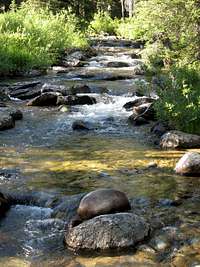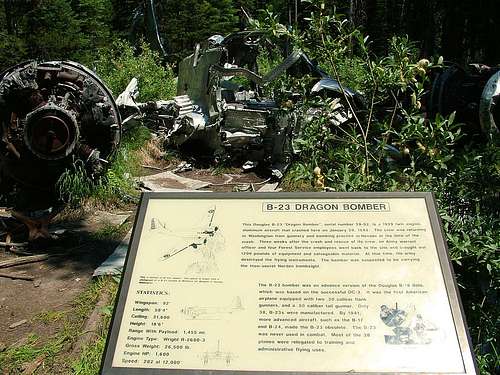|
|
Route |
|---|---|
|
|
45.15965°N / 115.8413°W |
|
|
Hiking |
|
|
Spring, Summer, Fall |
|
|
Most of a day |
|
|
Easy |
|
|
Overview
On January 29, 1943, the B-23 "Dragon Bomber" went down at Loon Lake (elevation 5,280') with eight men aboard. The plane was returning to McChord Field in Tacoma, Washington from a training mission in Nevada when it flew into a heavy snow storm near Pendleton, Oregon. Unable to maintain altitude, the pilot decided to attempt a landing in Boise. The approach was hampered by heavy icing and a failed radio. An order to prepare to parachute was given at 13,000'. Just then a hole developed in the cloud cover. A frozen lake was spotted and a landing was attempted. Frozen flaps caused the first approach to be abandoned. In a successful second approach, the plane touched down on the frozen lake, sliding across the ice and through the trees. With both wings sheared off, the plane came to rest 150 feet from the shore of Loon Lake in the timber.All eight men survived. A broken kneecap was the only injury...
WOW!
A short, enjoyable, yet nastalgic hike into the Payette National Forest reveals this small gem of a "find". My step-father brought this hike up to me and thought I would enjoy it. It ended up being an extremely rememberable and educational trip for my family and I.
Please Note: Shortly after our trip (hours) we had a thunder and lightning storm throughout the night which was the start of a large forest fire in the region. Surroundings could appear quite different than what is illustrated in my photos.
Getting There
Go to McCall, Idaho. Head north on Warren Wagon Road, past Upper Payette Lake, along the Secesh River until you get to Chinook Campground. From here the hike is approximately ten miles round-trip.Route Description
From Chinook Campground, take trail #080. This trail follows the Secesh River south towards Loon Creek. Just above Loon Creek take trail #084 west. This trail becomes rocky and steep with many switch-backs, rising 800 feet in elevation in 1.3 miles.
Trail #084 intersects with trail #081. Here there are two choices:
1.) Continue south along #081, leaving the trail to bushwack your way south along the east side of the lake.
2.) Continue south along #081 to the junction of trail #084. Head west again on #084. This trail runs 1.75 miles south along the west side of Loon Lake. Where the trail meets Loon Creek, leave the trail to follow the creek north to Loon Lake.
The wreckage is on the south side of Loon Lake, approximately 150 feet into the trees.
You may return the way you came, or you may follow trail #081 back north to Chinook Campground. Be aware that on #081, you must cross the Secesh River to reach the campground and there is no bridge. This is not advised during late spring and early summer or any time there is high water.
Essential Gear
Comfortable shoes as usual. Make sure you have a water filter or tablets since you will have access to water most of the way.Other Notes
The following was taken from an Idaho Statesman article published 01/29/93.
"Bomber Crash 50 Years Ago Began Ordeal For 8 Crewmen"
by Mark Carnopis
Fifty years ago today, eight crewmen of a bomber that crashed in northern Idaho began an odyssey of survival that continued for more than two weeks.
Everyone aboard the B-23 Dragon bomber, which veered off course in a snowstorm, survived the January 29, 1943, crash in the Payette National Forest about 15 miles northeast of McCall.
Five days later, three of the crewmen decided to hike out for help. On February 13, a Cascade bush pilot named Penn Stohr spotted the wreckage and the five men there. They were rescued the next day.
On Feb. 16, the three men who had left the crash site found a Civil Conservation Corps camp. One of them stayed there, while the other two hiked to a ranger station, where they phoned for help. They had traveled 42 miles in heavy snow before being rescued.
At the height of the search, the entire Second Air Force, which included the Army Air Corps from the entire Northwest, joined private pilots in scouring three states.
Efforts to contact one of the crewmen, Edward Freeborg, 69, of Portland, Oregon, were unsuccessful Thursday.
But Boise aviation historian Lowell Thompson provided a copy of a nine-page report of the crash purportedly written by Freeborg. Using that report, news stories of the crash and a 1991 newspaper interview with Freeborg, a Statesman reporter was able to compile the following account of the incident, which made headlines across the nation:
The Army Air Corps bomber, which was used for coastal patrol and in training missions, was en route from Tonopah, Nev., to McChord Field in Tacoma, Washington, the morning of Jan. 29 when it got lost in a blinding snowstorm and ended up over Idaho.
Efforts to find a suitable landing site in the rugged terrain were unsuccessful. With gas running low, the crew decided to try an emergency landing on Loon Lake, near Upper Payette Lake.
The bomber hit the far shore, sawing off 20-inch trees for about 100 yards. Both wings were sheared off and the nose was smashed, but the fuselage remained intact. The only injuries were a broken leg and a severely cut hand.
The crew searched the plane and found two 12-gauge shotguns and some emergency rations chocolate vitamin bars. The first night, they took turns gathering wood and sleeping on green pine boughs.
Freeborg said attempts to hike out of the area or make themselves more visible from the air were difficult.
"The future was none too bright for us, with no food... half starved, half frozen and a regular blizzard going on about us. This continued for about 10 days... covering every smoke signal we could make, and making it terribly cold and in general hampering all of our efforts in letting the outside world knowing of our whereabouts," he wrote.
He said those who tried to go looking for help "met with failure, due to exceptionally deep snow, with men in each case sinking into snow up to their waists and sometimes so deep they had to help each other out of the holes they had made."
On Feb. 1, Freeborg was able to fix the radio and send a message, which included a wrong location: "Crew intact, need food, clothing and an axe. At the south end of a lake near Boise, Idaho."
The night of Feb. 2, Freeborg and two other crewmen decided they would hike out for help. They left the next morning with small pieces of the chocolate, a shotgun and canteens.
"We hiked across the lake and up to the top of the mountain to look and see what type of territory we were going to have to climb out of," Freeborg wrote. "Believe me, that was the most disappointing sight I had ever hoped to see. Hills, hills and more hills in every direction. Believe me, I firmly believed that we looked in the face of death."
The first several days, all they ate were chocolate and one squirrel, which Freeborg shot. The fifth day, they found a small cabin with three cots and some food. They also saw a sign that said McCall was 25 miles away. They decided that two of them would keep hiking on the road.
On Feb. 13, Penn Stohr spotted the plane wreckage and crewmen while delivering mail by air. He could not land on the frozen lake, but came back the next day with a ski plane and rescued the five crewmen still with the bomber.
Stohr died in 1957 at the age of 54, his son, Dan Stohr, said in an interview Thursday from Boise. He died in a plane crash while doing aerial spraying in Montana.
Dan Stohr said his father never said much about the crash and rescue. "He was a very modest guy. Usually what I heard is what I read. He would just have assumed to stay out of the limelight."
Back in the wilderness, Freeborg and the others had found a camp mess hall and an Idaho National Forest booklet that included a map. Freeborg and another crewman decided to look for a ranger station that the map indicated was nearby. They followed telephone lines to the station, where they telephoned for help.
Fifty years later, remnants of the airplane remain, and it still is a popular site for hikers.
A Little Bit About The Bomber
The B-23 "Dragon Bomber," a 1939 twin engine aircraft, was developed from the Douglas B-18 and the DC-3. It was the first United States airplane equipped with tail gunners. Only 38 B-23's were manufactured. Most were assigned to the 34th Bomb Squadron at McChord Field in Washington State.By the time of the bombing on Pearl Harbor on December 7, 1941, more advanced aircraft such as the B-17 and B-24 made the B-23 obsolete. It never saw combat use. B-23's were used instead for training purposes.






